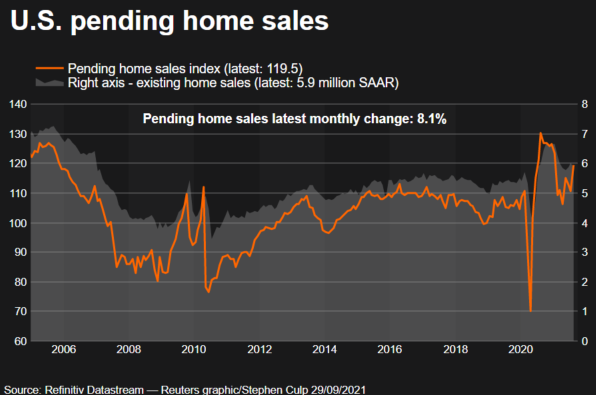Contracts to buy U.S. previously owned homes rebounded to a seven-month high in August, but higher prices as supply remains tight are slowing the housing market momentum.
Other data on Wednesday showed applications for loans to buy a house fell last week as mortgage rates increased after the Federal Reserve signaled it would likely begin reducing its monthly bond purchases as soon as November. There are indications that supply could improve in the fall.
“Supply constraints that are boosting prices are impacting affordability and have been a headwind for buyers,” said Rubeela Farooqi, chief U.S. economist at High Frequency Economics in White Plains, New York. “Gradually easing supply constraints should be a positive, although affordability concerns could temper sales in the very near term.”
The National Association of Realtors (NAR) said its Pending Home Sales Index, based on signed contracts, jumped 8.1% last month to 119.5. That was the highest reading since January and followed two straight monthly declines.
Economists polled by Reuters had forecast contracts, which become sales after a month or two, increasing 1.4%. Compared with a year ago, pending home sales fell 8.3% in August.
The housing market boomed early in the COVID-19 pandemic amid an exodus from cities as people worked from home and took classes online. But the pandemic tailwind is fading as vaccines allow workers to return to offices.


Expensive homes are also sidelining some first-time buyers from the market. The NAR reported last week that the share of first-time buyers was the smallest in more than 2-1/2 years in August. Existing home sales dropped last month.
Data on Tuesday showed consumer sentiment towards buying a home weakening for a third straight month in September and house prices posting record gains in July from a year-ago.
Lumber prices have plummeted from record highs scaled in May, which economists and realtors hope will encourage builders to ramp-up construction of single-family homes. The resumption of foreclosures after a pandemic moratorium is also expected to ease the inventory crunch.
But house prices are likely to remain elevated, which together with rising mortgage rates could further erode affordability. In a separate report on Wednesday, the Mortgage Bankers Association said applications for loans to buy a home fell 1.2% last week from the prior week.
Loan purchase applications were down 12% from a year ago. According to the MBA, mortgage rates across all loan types increased since last Wednesday’s announcement by the Fed, with the benchmark 30-year fixed rate reaching its highest level since early July.
The U.S. central bank’s massive monthly bond buying program to aid the economy’s recovery from the pandemic has helped to keep mortgage rates low. With U.S. Treasury yields rising in recent days, mortgage rates could creep higher, which could draw some buyers into the market in anticipation of further rises.
“We anticipate home sales will trend sideways over the remainder of 2021,” said Mahir Rasheed, a U.S. economist at Oxford Economics in New York.
The surge in pending home sales last month was led by the South and Midwest regions, where the NAR said house price increases have been generally moderate relative to the rest of the country. Contracts soared 10.4% in the Midwest and vaulted 8.6% in the densely populated South. They rose 4.6% in the Northeast and advanced 7.2% in the West.
read more…
reuters.com/world/us
This post was last modified on %s = human-readable time difference 8:18 am
Just back out of hospital in early March for home recovery. Therapist coming today.
Sales fell 5.9% from September and 28.4% from one year ago.
Housing starts decreased 4.2% to a seasonally adjusted annual rate of 1.43 million units in…
OneKey MLS reported a regional closed median sale price of $585,000, representing a 2.50% decrease…
The prices of building materials decreased 0.2% in October
Mortgage rates went from 7.37% yesterday to 6.67% as of this writing.
This website uses cookies.